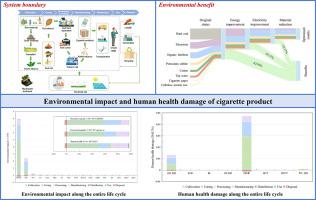卷烟生产、消费和处置对环境的影响和对人类健康的损害
IF 10.9
1区 环境科学与生态学
Q1 ENGINEERING, ENVIRONMENTAL
引用次数: 0
摘要
虽然吸烟对健康的危害已得到广泛认识,但烟草生产、消费和处置对环境的影响和对人类健康的损害往往不为人所知。全球香烟产量超过6万亿支,环境负担和健康风险受到越来越多的关注。本研究利用中国卷烟生产的实际数据构建了一个生命周期清单,首次量化了整个供应链对环境和人类健康的影响。研究结果表明,细颗粒物的形成是主要的环境影响类别,其次是全球变暖,烟草种植、烘烤和制造被确定为关键过程。从全球烟草种植到生产的碳排放量每年超过9200万吨。负面环境影响导致的残疾调整生命年为3.61 × 105年,换算成全球人均健康寿命平均损失23.74分钟。优化措施侧重于能源选择,电力改进和材料减少提出。具体而言,选择清洁能源,减少化肥、灌溉用水、过滤器和包装材料,以及加强对烟草秸秆和烟头的管理,可以显著减少对环境的影响和对人体健康的损害。提高公众意识和控制香烟消费仍然是解决这一全球性问题的最有效办法。本文章由计算机程序翻译,如有差异,请以英文原文为准。

Environmental impact and human health damage of cigarette production, consumption and disposal
Although the health hazards of smoking are widely recognized, the environmental impact and human health damage of cigarette production, consumption, and disposal often go unnoticed. With over 6 trillion cigarettes produced globally, the environmental burden and health risks are increasingly scrutinized. This study constructs a life cycle inventory using actual data from cigarette production in China to quantify the environmental and human health impacts across the entire supply chain for the first time. Findings indicate that fine particulate matter formation is the primary environmental impact category, followed by global warming, with tobacco cultivation, curing, and manufacturing identified as key processes. Carbon emissions from global tobacco cultivation to manufaturing exceed 92 Mt annualy. Disability-adjusted life years because of negative environmental impacts amount to 3.61 × 105, translating into a global average loss of 23.74 min of healthy life lost per capita. Optimization measures focusing on energy options, electricity improvements, and materials reduction are proposed. Specifically, choosing clean energy sources, reducing chemical fertilizers, irrigation water, filters, and packaging materials, as well as strengthening the management of tobacco straw and cigarette butts can significantly reduce environmental impact and human health damage. Increasing public awareness and controlling cigarette consumption remain the most effective solutions to this global issue.
求助全文
通过发布文献求助,成功后即可免费获取论文全文。
去求助
来源期刊

Resources Conservation and Recycling
环境科学-工程:环境
CiteScore
22.90
自引率
6.10%
发文量
625
审稿时长
23 days
期刊介绍:
The journal Resources, Conservation & Recycling welcomes contributions from research, which consider sustainable management and conservation of resources. The journal prioritizes understanding the transformation processes crucial for transitioning toward more sustainable production and consumption systems. It highlights technological, economic, institutional, and policy aspects related to specific resource management practices such as conservation, recycling, and resource substitution, as well as broader strategies like improving resource productivity and restructuring production and consumption patterns.
Contributions may address regional, national, or international scales and can range from individual resources or technologies to entire sectors or systems. Authors are encouraged to explore scientific and methodological issues alongside practical, environmental, and economic implications. However, manuscripts focusing solely on laboratory experiments without discussing their broader implications will not be considered for publication in the journal.
 求助内容:
求助内容: 应助结果提醒方式:
应助结果提醒方式:


